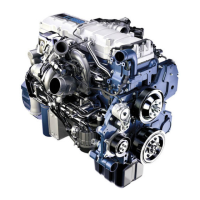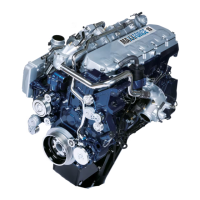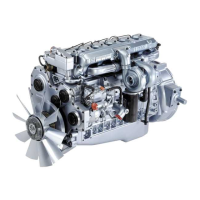10 TERMINOLOGY 587
Direct Current (DC) – An electric current flowing in
one direction only and substantially constant in value.
Disable – A computer decision that deactivates a
system and prevents operation of the system.
Displacement – The stroke of the piston multiplied by
the area of the cylinder bore multiplied by the number
of cylinders in the engine.
Driveline Disengagement Switch (DDS) – Aswitch
that indicates when the driveline is disengaged from
the engine.
Driver (high side) – Atransistorinanelectronic
module that controls the power to an actuator circuit.
Driver (low side) – A transistor in an electronic
modulethatcontrolsthegroundtoanactuatorcircuit.
Drivetrain data link (CAN 1) J1939 – The primary
communication link for the ECM, ESC, and instrument
cluster.
Duty cycle – A c ontrol signal that has a controlled
on/off time measuremen t from 0 to 1 00 % . Normally
used to control solenoids.
Elastomer – An elastic , rubber like substance such
as natural or synthetic rubber material. (SAE J111
MAR85)
Electronic Control Module (ECM) – The Electronic
Control Module is an electronic microprocessor that
monitors and controls engine performance, exhaust
emissions, and vehicle system performance (cruise
control, transmission control, starter engagement,
etc.). The ECM provides diagnostic information for
engine and vehicle systems and can be programmed
at different levels for engine protection, warning, and
shutdown.
Electronic Service Tool (EST) – Acomputer
diagnostic and program ming tool for the ECM and
ESC. The hardware is typically a laptop computer or
notebook computer. The diagnostic and programming
software includes International Master Diagnostics,
ISIS on-line documentation, and NETS for factory
programming.
Electronic System Controller (ESC) – An electronic
module that provides multiple analog and switched
input interfaces to monitor vehicle f un c t ions thro ugh
solid state switches, relay driver outputs, and serial
data communication.
Engine Control Module (ECM) power relay – An
ECM c ontrolled relay that supplies power to the ECM.
Engine Coolant Temperature (ECT) sensor –
A th ermistor sensor that sense s eng ine co o lant
temperature.
Engine Fuel Pressure (EFP) sensor – A variable
capacitance sensor that senses fuel pressure.
Engine Family Rating Code (EFRC) – A readable
code in the calibration list of the EST tha t identifies
engine horsepower and emission calibrations.
Engine lamp – An instrument panel lamp that comes
on when DTCs are set. DTCs can be read as flash
codes (red and amber instrument panel lamps).
Engine OFF tests – Tests that are done with the
ignition key O N and the engine OFF.
Engine RUNNING tests – Tests done with the engine
running.
Engine Oil Pressure (EOP) sensor – A variable
capacitance sensor that senses engine oil pressure.
Engine Oil Temperature (EOT) sensor – A
thermistor sensor that senses engine oil temperature.
Exhaust brake – A brake device using eng ine
exhaust back pressure as a retarding medium.
Exhaust Gas Recirculation (EGR) – The Exhaust
Gas Recirculation is a s ystem that recy cles a
controlled portion of exhaust gas back into the
combustion chamber to reduce Nitrogen Oxide
exhaust emissions.
Exhaust Gas Recirculation (EGR) drive module –
The EGR drive mod u le controls the position of the
EGR valve.
Exhaust Gas Recirculation (EGR) cooler – The
exhaust gas is cooled in the EGR cooler and flows
through the EGR control valve to the EGR mixer duct.
Exhaust G as Recirculation (EGR) valve – The EGR
valve, when open, will mix exhaust gas with filtered
intake air which flows into the intake manifold. The
EGR valve, when c losed, only allows fi ltered air to flow
into the intake manifold.
Exhaust manifold – Exhaust gases flow through the
exhaust manifold to the turbocharger exhaust inlet and
are direc te d to th e EGR cooler or out the ex ha ust
system.
EGES-270-1
Read all safety instructions in the "Safety Information" section of this manual before doing any procedures.
Follow all warnings, cautions, and notes.
© August 2008 Navistar, Inc.

